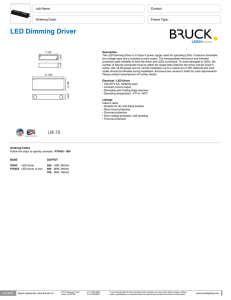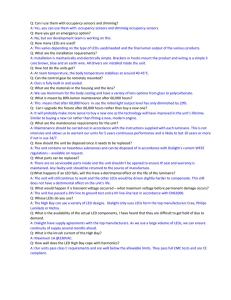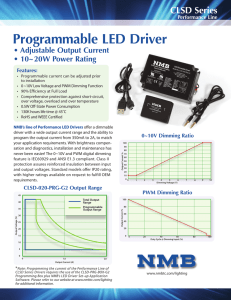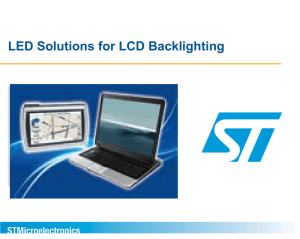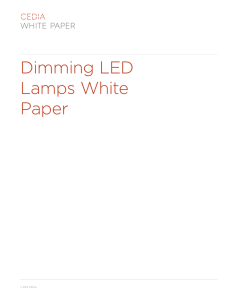Controlling LEDs to Meet Customer Expectations
advertisement
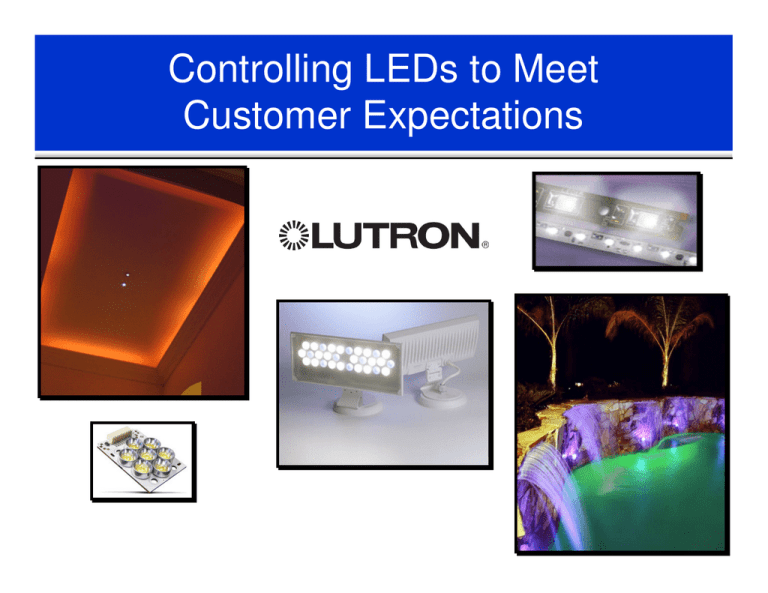
Controlling LEDs to Meet Customer Expectations 1 LearningObjectives Objectives Learning • Through examination of the LED industry, the participant will be able to describe the features and benefits of LEDs as a general illumination light source, and the applications where LEDs excel to ensure operational safety and occupant productivity • Studying the components of an LED system will enable the participant to explain an LED luminaire and each component involved to ensure effective and safe operation • By examining existing control types and standards, the participant will be able to identify the differences between power line, 3 wire and low voltage control • Analysis of LED drivers will enable the participant to identify the differences between constant current and constant voltage drivers and which applications require which type of driver to ensure safe operation and expected performance 2 Agenda Agenda • LED Features, Benefits, and Challenges • LED Applications • Why Dim and Dimming Expectations • LED Technology • LED Drivers • LED Control Options 3 LED Features and Benefits • Energy savings – 25W LED or less can replace a 100W incandescent • Reduced maintenance costs – 50,000 hour lifetime • Color Rendering – 90 CRI or higher is possible • Immediate light output • No UV/IR radiation or mercury 4 LED Challenges • System compatibility – driver/LED array and driver/control compatibility are often confusing • Thermal management – heat must be conducted away from LED’s effectively • Color consistency – color shift in LED light output can occur • Exaggerated claims 5 Commercial LED Applications LEDs are making great strides, and products now exist for replacing almost any fixture type: – Downlights – Cove Lights – Outdoor Lighting However, you must be wary when selecting a product to ensure it is truly a comparable replacement 6 Residential LED Applications LEDs are making great strides, and products now exist for replacing almost any fixture type: – Downlights – Under Cabinet Lights – Decorative/Accent Lights However, you must be wary when selecting a product to ensure it is truly a comparable replacement 7 LED Applications – LEDs are championed as a versatile light source with a multitude of control options – Compatibility issues between products hinder these benefits from becoming a reality – LED lighting manufacturers must consider their control options in the design phase 8 Why Dim? Dimming: • Saves Energy • Extends System Life • Enhances Ambiance • Provides Space Flexibility • Increases Productivity • Provides Safety and Comfort 9 Dimming Expectations • The expectation of dimming needs to be defined • The customer expects dimming to be down to a 1% light level or less (similar to incandescent) • LED products should specify the lowest light level that they can maintain for dimming 10 Dimming Expectations Difference between measured and perceived light – Measured light: the amount of light as shown on a light meter – Perceived light: the amount of light that your eye interprets due to dilation – 20% measured = 47% perceived 11 Dimming Expectations Lobby or Atrium: A 20% light level is acceptable for this application Restaurants: A 1% light level is necessary for this application 12 Dimming Expectations Dimming problems we need to eliminate: – – – – – – Flicker Shimmer Pop-on Drop out Flicker Minimum light level These have been solved with existing light sources, why accept them with LEDs? 13 LED Technology LED System Example: 14 LED Technology LED Arrays: • For general illumination, LEDs are used in LED arrays or LED light engines • These arrays can then be used within a lamp or within a fixture, both of which are powered by a driver 15 LED Technology LEDi Lamps: • LEDi lamps have screw-in bases in order to replace existing incandescent or CFL screw-in lamps • LEDi lamps always have integral drivers Many LEDi’s don’t live up to the customer’s expectations, and many are non-dimmable 16 LED Technology LED Fixtures: • LED fixtures have LED arrays mounted inside them • They may have an integral driver or a separate driver (similar to a ballast) • Many LED fixtures exist, ranging from traditional designs to unique LED specific designs 17 LED Drivers • Two types of LED drivers exist: – Constant Current – Constant Voltage • They are NOT interchangeable • The correct driver to use is determined by the needs of the LEDs and is usually application based 18 LED Drivers Constant Voltage Output: • Provides a constant voltage to the LEDs • Used when the user needs flexibility in number of luminaires or length of cove controlled by one power supply • As lamps are added, current increases to a max limit 19 LED Drivers Constant Current Output: • Driver provides a constant current to the LEDs • Used when the user needs one driver for each luminaire, which is more efficient • Whether the fixture has 18 LEDs or 6 LEDs, the current out of the driver remains the same 20 LED Control Options LED System Example: 21 LED Control Options Types of control: • Phase control • 3-wire control • Low voltage control – Analog – Digital – Other 22 LED Control Options Phase Control: Phase Control Dimmer LED Lamp with integral driver Hot Neutral • Typically used to control an LEDi lamp • Incandescent (forward phase control) dimmers generally do not work well with LEDs • Reverse phase control dimmers tend to have better performance, but they often require a neutral wire connection 23 LED Control Options Phase Control: Types of line voltage Leading Edge/Forward phase: – Incandescent – Magnetic low voltage transformers Trailing Edge/Reverse phase: – Electronic low voltage transformers To use these controls: • Confirm the product follows the existing standards • Contact the control and lamp manufacturer to confirm compatibility 24 LED Control Options 3-Wire Control: • 3-wire control for both small and large scale systems • Uses established wiring protocol for fluorescent controls • Separate control and power feed allows for more precise control and high power quality Hot Neutral Dimmed Hot Switched Hot 25 LED Control Options Low Voltage Control: Analog • 0 -10V Digital • DMX-512 • DALI Other 26 LED Control Options 0-10 Volt Control (analog): • IEC standard exists (IEC 60929) • Two control methods: current sink and current source • Only control as current sink is recognized by the IEC standard and is compatible with installed/existing controls Line Voltage Low Voltage 0 to 10 V Control 27 LED Control Options DMX 512 (digital): • ANSI Standard (USITT DMX 512-A) • Protocol used primarily for mixing colors and varying color intensity • Multiple channels required • Applications: Theatrical • Problematic when used in general illumination due to complicated wiring and lack of simple integration with standard building controls 28 LED Control Options DALI – Digital Addressable lighting Interface (digital): • Developed as a fluorescent ballast communication standard (IEC 60929) • Allows for individual addressing of fixtures • Uses digital signals to send control information to the LED drivers 29 Summary • This is the “Wild West”… manufacturers are creating new control needs by disregarding standards and are not developing new controls to work with them. • Custom controls create problems when operated on existing controls or when integrated into a control system. • Dimming is important to ensure the correct light level for the task at hand and space ambiance and décor. • LED lighting is an emerging technology that requires a system approach to meet customer lighting expectations • In order to meet the customers expectations and ensure that all parts of an LED system dim properly and safely, talk to both the control and lamp manufacturers. 30 Questions? 31
